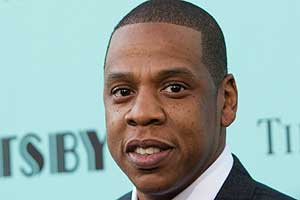
He’s not a rap man, he’s an app, man. The drop of Jay-Z’s new album Magna Carta . . . Holy Grail at midnight on Independence Day seemed less like a musical event than like a Silicon Valley IPO.
Conveyed exclusively by a Samsung application to a million Galaxy phone and tablet users, the release not only forced old-media institutions to rewrite their rules and raised complaints about NSA-style invasions of privacy, but came with a glitch that crashed the promised downloads; the only other way to hear it that night was through a stream from Hot 97 over which DJ Funkmaster Flex interpolated hype-man exclamations that mostly dissed iPhones.
Rubbing out the boundary between art and entrepreneurship always has been part of Jay-Z’s hustle. But now that some of the pixelated fog has dissipated and we’ve had the long weekend to listen to the leaks, how does the music measure up For a creator who crows, “Oh, I’m so good at math,” Jay’s made a product that’s less than the sum of its impressive surfaces.
The production, by Timbaland, Pharrell Williams, The-Dream, Hit-Boy and others (including WondaGurl, a 16-year-old from Ontario), gleams like the luxury good it is. But the music is only intermittently moving to head, hips or heart.
The most enticing sonics, like the New Orleans horns on “Somewhereinamerica,” seldom coincide with the freshest bars – even if “Somewhere in America, Miley Cyrus is still twerkin’ ” rivals Kanye West’s “Hurry up with my damn croissants!” as 2013’s funniest cross-cultural-double-dutch twist.
While Mr. Carter’s status as an Old Master of rapping is not in doubt, the “old” side of that equation weighs heavier and Hovier. His sights never quite lock in. The multilevel wordplay, wit and wisdom that are his calling cards flicker amid the Fortune 500 asset inventories and street-cred callbacks, and punch lines that often warrant the lamentable tag of Dad Rap.
In the artist’s defence, there aren’t many rappers who’ve survived long enough, physically, psychologically and commercially, to grapple with aging with dignity the way jazz, blues, country and (sometimes) rock personalities do. His star has risen right off the road map, as was bound to happen to someone in the genre’s fourth decade. But with the tech at his disposal, perhaps a few extra features engineered into the Magna Carta app would have helped. For example:
Ad Feedback
1. Reference Auto-Refresher
This search-and-replace engine would catch all the pop-culture references that make Jay seem mired in the 1990s and offer more up-to-date options.
It would flag names he’s dropped repeatedly in the past – is he honestly still worrying he’ll end up like Mike Tyson or MC Hammer – and tropes tired out within the album itself: If he must keep making Mafia/Roc-A-fella parallels, isn’t it time to come up with models other than The Godfather and Goodfellas (He twice repeats a dinero/De Niro joke he first made in 1996 on “Bring It On.”) Like at least The Sopranos And move on from Colombian drug cartels to, say, Mexican ones
This program also might delete Jay’s attempts to top his own classics – the Part II (On the Run) duet with Beyonc